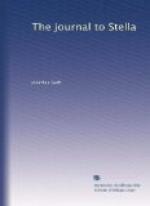12 Apologies.
13 “A Description of the Morning,” in No. 9 of the Tatler.
14 See Letter 6, note 19.
15 William Palliser (died 1726).
16 See Letter 4, note 15.
17 “Here he writ with his eyes shut; and the writing is somewhat crooked, although as well in other respects as if his eyes had been open” (Deane Swift).
18 Tatler, No. 249; cf. p. 93. During this visit to London Swift contributed to only three Tatlers, viz. Nos. 230, 238, and 258.
19 St. Andrew’s Day.
20 No. 241.
21 Tatler, No. 258.
22 Lieutenant-General Philip Bragg, Colonel of the 28th Regiment of Foot, and M.P. for Armagh, died in 1759.
23 James Cecil, fifth Earl of Salisbury, who died in 1728.
24 See Letter 2, note 13.
25 See Letter 8, note 22.
26 Kneller seems never to have painted Swift’s portrait.
27 On Nov. 25 and 28.
28 Arthur Annesley, M.P. for Cambridge University, had recently become fifth Earl of Anglesea, on the death of his brother (see Letter 3, note 35). Under George I. he was Joint Treasurer of Ireland, and Treasurer at War.
29 A Short Character of the Earl of Wharton, by Swift himself, though the authorship was not suspected at the time. “Archbishop King,” says Scott, “would have hardly otherwise ventured to mention it to Swift in his letter of Jan. 9, 1710, as ‘a wound given in the dark.’” Elsewhere, however, in a note, Swift hints that Archbishop King was really aware of the authorship of the pamphlet.
30 A false report. (See Letter 11, note 4.)
31 None of these Commissioners of Revenue lost their places at this time. Samuel Ogle was Commissioner from 1699 to 1714; John South from 1696 until his death in 1711; and Sir William St. Quintin, Bart., from 1706 to 1713. Stephen Ludlow succeeded South in September 1711.
32 See Letter 7, note 35.
33 James Hamilton, sixth Earl of Abercorn (1656-1734), a Scotch peer who had strongly supported the Union of 1706.
Letter 11.
1 L’Estrange speaks of “insipid twittle twattles.” Johnson calls this “a vile word.”
2 A cousin of Swift’s; probably a son of William Swift.
3 Nicholas Sankey (died 1722) succeeded Lord Lovelace as Colonel of a Regiment of Foot in Ireland in 1689. He became Brigadier-General in 1704, Major-General 1707, and Lieutenant-General 1710. He served in Spain, and was taken prisoner at the battle of the Caya in 1709.
4 See Letter 10, note 30.
5 The Earl of Abercorn (see Letter 10, note 33) married, in 1686, Elizabeth, only child of Sir Robert Reading, Bart., of Dublin, by Jane, Dowager Countess of Mountrath. Lady Abercorn survived her husband twenty years, dying in 1754, aged eighty-six.
6 Charles Lennox, first Duke of Richmond and Gordon (1672-1723), was the illegitimate son of Charles ii. by Madame de Querouaille.




